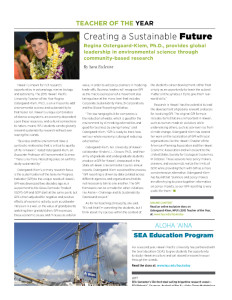Regina Ostergaard-Klem, Ph.D., provides global leadership in environmental science through community-based research
Hawai‘i is known for rich research opportunities in volcanology, marine biology and astronomy. The 2015 Hawai‘i Pacific University Teacher of the Year Regina Ostergaard-Klem, Ph.D., is on a mission to add environmental science and sustainability to that honor roll. Because of Hawai‘i’s unique combination of diverse ecosystems, an economy dependent upon those resources, and cultural connections to nature, HPU students can do globally relevant sustainability research without ever leaving the islands. “Business and the environment have a symbiotic relationship that is critical to quality of life in Hawai‘i,” noted Ostergaard-Klem, an Associate Professor of Environmental Science. “There is no more interesting place on earth to study sustainability.”
Ostergaard-Klem’s primary research focus is the customization of the Genuine Progress Indicator (GPI) to the unique needs of Hawai‘i. GPI was developed two decades ago as a supplement to the Gross Domestic Product (GDP). GPI and GDP start at the same point, but GPI is then adjusted for negative and positive effects of economic activity, such as saltwater intrusion in a well, or the value of grandparents watching their grandchildren. GPI expresses these economic pluses and minuses as a dollar value, in order to aid policy planners in modeling trade-offs. Business leaders will recognize GPI as the macro expression of a movement also taking place at the micro level that includes Corporate Sustainability Plans, B-Corporations and the Global Reporting Initiative. “The low hanging fruit for companies is the reduction of waste, which is good for the environment by eliminating externalities and good for business by saving money,” said Ostergaard-Klem. “GPI is a way to track how well our whole economy is doing at reducing externalities.”
Ostergaard-Klem, her University of Hawai‘i collaborator Kirsten L.L. Oleson, Ph.D., and their army of graduate and undergraduate students produce a GPI for Hawai‘i, showcased in the State of Hawaii Environmental Council annual reports. Ostergaard-Klem explained the process: “GPI reporting is driven by data collated across different agencies and organizations that do not necessarily talk to one another. The GPI framework can be a model for other initiatives like Aloha + Challenge and its Sustainability Dashboard project. Our students gain real-world experience collaborating with community organizations to develop locally important deliverables, a key part of Ostergaard-Klem’s teaching philosophy. “It’s not that I’m parenting the students, but I think about my courses within the context of the student’s career development, rather than simply as an opportunity to teach the subject matter on the syllabus,” said Ostergaard-Klem. “I try to give them real-world skills.”
Research in Hawai‘i has the potential to lead the development of globally relevant protocols for localizing GPI. The original GPI formula includes items that are unimportant in Hawai‘i, such as human-made air pollution, while undervaluing others, such as sea-level rise from climate change. Ostergaard-Klem has shared her work on the localization of GPI with local organizations like the Hawai‘i Chapter of the American Planning Association and the Hawaii Economic Association and will present to the United States Society for Ecological Economics In October. These sessions help policy makers, planners, and economists realize the limits of GDP, while providing them with GPI as a more comprehensive alternative. Ostergaard-Klem has found that “planners and policy makers are often trying to piece together information on policy impacts, so our GPI reporting is very useful for them.”
This article originally appeared in the summer 2015 issue of HPU Today.
